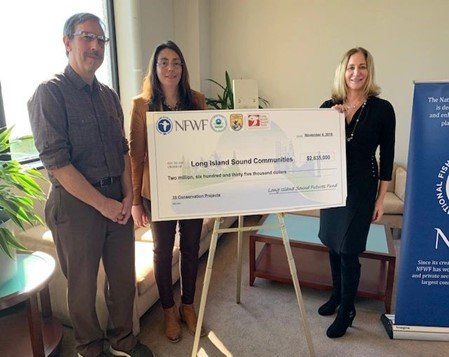GREEN INFRASTRUCTURE - LEVERAGING PARKING DOLLARS TO ACHIEVE ENVIRONMENTAL GOALS
We have been hearing a lot lately about climate change, going green, green initiatives and green infrastructure. These are not new concepts but are now priorities across government and business sectors accelerated by behavior changes during the pandemic. The Parking Industry is an important part of economic and community development and critical to effectively and efficiently implementing environmental initiatives to create sustainable communities and enhance quality of life. The opportunities are endless.
Green Infrastructure installations not only help the environment, but also beautify an otherwise unpleasant sea of parked cars.
What is Green Infrastructure:
Green infrastructure is an approach to water management that protects, restores, or mimics the natural water cycle. Green infrastructure is effective, economical, and enhances community safety and quality of life. It means planting trees and restoring wetlands, rather than building a costly new water treatment plant and/or installing new drainage. It uses vegetation, soils, and other elements and practices to restore some of the natural processes required to manage water and create healthier urban environments.
Why We Need Green Infrastructure:
Storm runoff is a greater problem in urban areas where pavement and other non-porous surfaces prevent much of it from soaking into the ground. When rains are particularly heavy erosion and flooding can occur causing damage to property and other infrastructure. Stormwater is also a major cause of pollution. The runoff can carry trash, bacteria, and other pollutants with it. Traditionally, the infrastructure to move storm water safely in cities includes costly pipes for drainage and water treatment systems.
A Case Study in Norwalk, CT
The Webster Parking Lot, located in the SoNo District in Norwalk, CT near Long Island Sound, is a 600-space surface parking lot that serves a diverse group of businesses. This critical parking resource experienced consistent flooding over many years during major rainstorms. Specifically, during 2018 there were two major rainstorms that caused substantial flooding to neighboring businesses. In 2018, my team from the Transportation, Mobility and Parking (TMP) Department partnered with the Department of Public Works (DPW). Instead of recommending a costly drainage replacement project which would have required the City of Norwalk to invest millions of dollars and cause major disruption to the business community for a long period of time, the teams developed an innovative approach and solution to help alleviate flooding in the area and also create an environmental landscape that would fit into the City of Norwalk’s long term environmental sustainability and resiliency plan as well as goals and objectives for climate change and stormwater management as identified in the 2019 Plan of Conservation and Development- Norwalk CT Plan of Conservation and Development (POCD) 2019 - 2029 Norwalk’s harbor and river are vital components of the city’s commerce and leisure industries which depend on the riverfront including fishing, aquaculture and the largest oystering business since the 1940’s (copps island oysters).
My team and I applied for a green infrastructure grant in 2018 from the Environmental Protection Agency (EPA) through the Long Island Sound Futures Fund (LISFF) which is managed by the National Fish and Wildlife Foundation. The LISFF announced 35 grants, totaling $2.6 million to state and local government and community groups to improve the health and ecosystem of the Long Island Sound. The City of Norwalk received a $250,000 grant. The grant required a substantial match. A $400,00 match was approved the Norwalk Parking Authority from their capital investment budget.
The design identified four distinct types of infrastructure installations:
1. Underground infiltration systems.
2. Retention basins and curb inlet planters in eight different areas.
3. Porous pavement with storage in two areas.
4. Infiltration gutters and tree filters in two other areas.
This type of green infrastructure installation is designed to filter and absorb storm water more efficiently while also providing aesthetic improvements including landscaping and greening installations. It is estimated that this green infrastructure installation will prevent 6 million gallons of storm water and 12 pounds of nitrogen from going into the Long Island Sound.
The LISS Fund offers grants to projects led by communities aiming to improve water quality and restore habitat around the Long Island Sound watershed. The 2019 distributed grants will reach more than 200,000 residents through environmental education programs and conservation projects including treating 8.2 million gallons of storm water, collecting 46,000 pounds of floating trash, installing 23,000 square feet of green infrastructure, and preventing 17,000 pounds of nitrogen from entering the Sound.
The project was initially expected to be complete in 2020 but was delayed due to the pandemic. Completion is expected Spring 2022.
WEBSTER PARKING LOT - GREEN INFRASTRUCTURE AREA
Green Infrastructure Installation Dec. 2021
LISS AWARD PRESS CONFERENCE - 2019
(L-R) Mike Yeosock, Assistant Director TMP; Vanessa Valadares, Principal Engineer; Kathryn Hebert, DIrector TMP
Green Initiatives and Parking
The City of Norwalk matched LISS grant funding requirements by leveraging parking dollars through the Norwalk Parking Authority to pay for a green infrastructure solution to help alleviate constant flooding of a highly active parking lot in a major downtown district.
Green initiatives have been around for a long time. Now, the benefit and necessity of installing green initiatives have been highlighted and accelerated during the pandemic including reimagining and repurposing of parking facilities to accommodate these types of initiatives to create public engagement and connectivity. To name a few, creating tree canopies to install safer and more desirable pedestrian ways, green walls and roofs, pervious pavements, community and rain gardens, outdoor plazas and shaded seating, electric vehicle charging stations, bike parking. At every level of government and business sectors, climate change and the environment are a topic of conversation with funded legislative mandates and partnerships.
Leveraging parking dollars and integrating parking management and technology is an integral component and partner of these important environmental initiatives. The opportunities are endless.
Kathryn Hebert
President and CEO, TPMConnect
Former Director Transportation, Mobility and Parking, City of Norwalk





